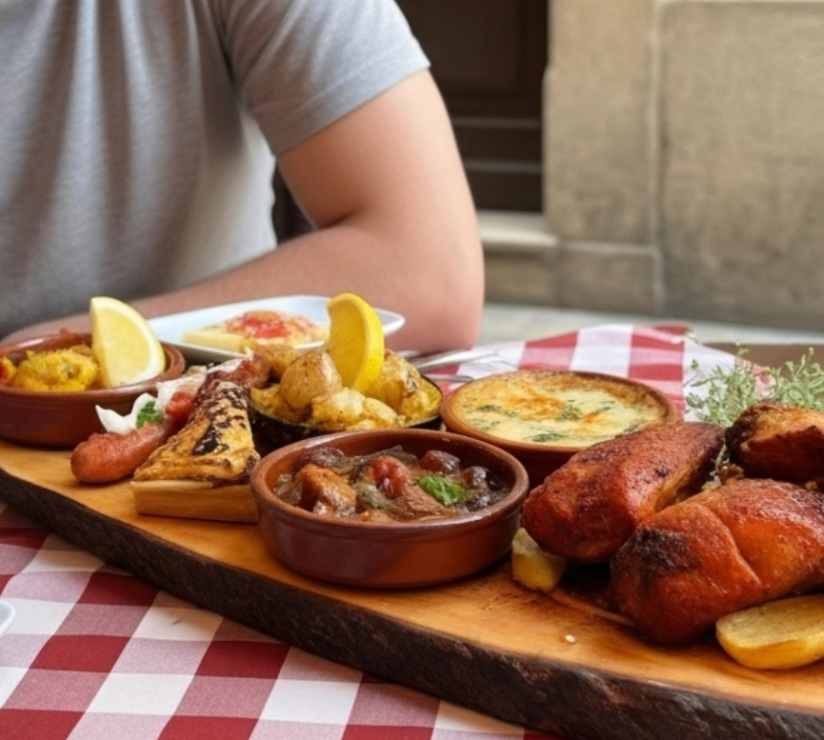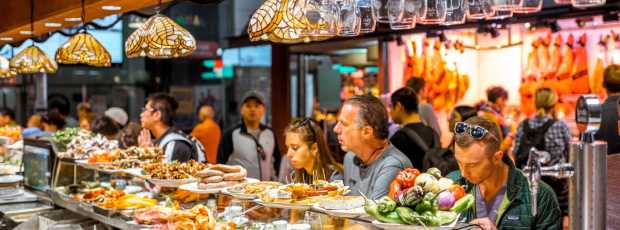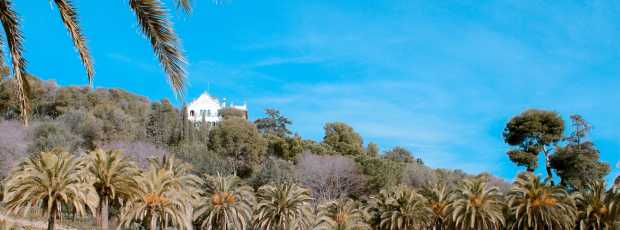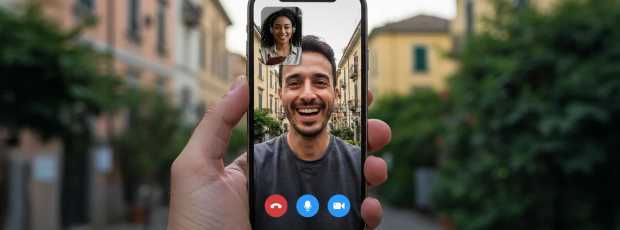Table Of Contents
- What Are Barcelona’s Signature Dishes and Local Classics?
- My Must-Eat in Barcelona
- How Global Is Barcelona’s Food Scene Right Now?
- Where Should You Grab Street Food in Barcelona?
- Sweet Treats and Desserts
- What Do Locals Actually Drink, and When?
- Unique Local Food Traditions
- Seasonal Specialties
- Overrated Food Experiences
- Practical Tips for Eating in Barcelona
- Frequently Asked Questions
- Final Thoughts

Busy neighborhood bodega counter with chalkboard menu at Pinotxo bar
Memorable Barcelona experiences run on a different clock. Mornings start at the market.
Lunch is a proper menú del día, three courses with wine, finished by 3 PM. Then comes vermouth hour, standing at a marble counter with the newspaper crowd.
Dinner happens late, if it happens at all. Most nights I'm eating tapas at 10 PM, arguing about brava sauce with the bartender.
This guide cuts through the theatre. I'll tell you what's worth queuing for and what's just Instagram bait.
I'll point you toward the rice houses locals actually book and the bodegas where standing room means you're doing it right. I'll show you the same route I walk with friends when they visit, the same bars where I've eaten three times a week for the past decade.
For the full picture of what to eat in Barcelona and beyond, that's your starting point. When I host friends, we start with a market lap, then a menú del día before we even think about tapas.
Imagine Experiencing Barcelona for Real
A local can show you the vibe, flavors, and hidden gems up close.
What Are Barcelona’s Signature Dishes and Local Classics?
The Barcelona food scene starts with the classics. These are the dishes that define Catalan cuisine. Food lovers travel here specifically for these flavors. Each one tells a story about this city.

Couple enjoying paella together
Seafood Paella (and Fideuà)
Sunday lunch by the sea is a ritual here. You book a table at a rice house in La Barceloneta. You order seafood paella or fideuà. You watch the Mediterranean while the kitchen chars the bottom of the pan just right.
Good paella is about technique. The rice gets toasted first in a shallow pan. The fish stock should come up to the grain line, not drown it. You want that socarrat, the crispy caramelized layer at the bottom.
This iconic Spanish dish should taste like the sea, not like saffron-flavored risotto. Fresh seafood makes all the difference.
Avoid La Rambla terraces. Just avoid them. Go to Can Solé instead. It opened in 1903, and the fourth generation still runs the kitchen.
Or try La Mar Salada, where the dining room faces the promenade and the rice is always perfect. Can Majó is the other one, right on the boardwalk, packed on weekends for good reason. Book ahead. These places fill up by noon on Sundays.
Fideuà is the same idea, but with short noodles instead of rice. Some people prefer it. I'm not one of them, but I respect the position. Both dishes showcase fresh seafood beautifully.

Friends enjoying Pa Amb Tomàquet
Pa Amb Tomàquet
This is the table starter you'll see everywhere. Catalans call it pa amb tomàquet. Spanish speakers say pan con tomate. It's the same thing.
Toasted bread, rubbed with fresh garlic, smeared with ripe tomato, finished with good extra virgin olive oil and salt. That's it. Four ingredients. Five, if you count the fresh bread.
What separates good pan con tomate from bad is bread quality and olive oil. If the bread tastes like cardboard or the oil has no bite, send it back. Actually, just leave.
People pair it with Spanish cured ham, anchovies, or Manchego cheese. All fine choices. Iberico ham is the premium move. Thin slices of Iberian ham from the Iberian pig, salt-cured for months.
The real Catalan cheese hero is mató, a fresh curd cheese. You usually see that with honey as a dessert. I judge restaurants by their pan con tomate. If they can't get this right, they're not getting the rest right either.
You'll find this popular dish at almost every tapas bar in the city. It's a test of competence.
Order it, then judge the bread and oil like you live here.
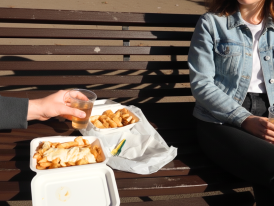
Crispy patatas bravas with aioli
Patatas Bravas
Every tapas bar in this city serves bravas. Not every bar should.
The test is simple. The potatoes should be crispy cubes, fried twice if the kitchen knows what it's doing. These crispy potatoes, or fried potato cubes, need proper texture. The brava sauce should have bite, real heat, not just paprika-tinted mayo. Some places add aioli on the side. That's fine. The spicy sauce is the thing.
Bar Tomás, also called El Tomás de Sarrià, has made bravas the same way since the 1950s. People take the metro across the city for them. I've done it. Worth it.
Senyor Vermut in Eixample does a version I respect. Not traditional, a little more refined, but the crispy potatoes stay perfect, and the sauce has backbone.
Red flag: if a place serves you French fries with ketchup-mayo and calls it bravas, walk out. Don't finish your drink. Just go. Bravas are a bar's honesty test.
Go Beyond the Barcelona Checklist
Discover the city guidebooks don’t cover with a local by your side.

Croquetas cracked open with a creamy center
Croquetas
A good croqueta breaks like silk. The outside shatters. The bechamel sauce inside stays molten and smooth. It should never taste like mashed potatoes with breadcrumbs.
The filling matters. Ham is classic. Mushroom works. Bacalao, salt cod, is the move if they offer it. These delicious tapas appear on every menu worth reading.
Bar del Pla in El Born makes some of the best I've had. Order a few types. They'll bring them out served hot, and you'll burn your tongue because you can't wait. Quimet & Quimet in Poble-sec does them too. That place is standing room only, elbow to elbow, a beautiful chaos I'll talk about later.

Esqueixada with green oil sheen
Esqueixada de Bacallà
This is the city's lightest salty lunch. Shredded salt cod, hand-pulled into threads. Mixed with tomato, onion, and enough olive oil to make it shine. A summer staple in Barcelona's food culture.
You order this where the oil is cared for, where they're not cutting corners. Some places add green olives or strips of roasted red peppers. Both good additions. It's cold, refreshing, bright with acid. Goes well with bread and a glass of great wine.
Don't overthink it. This Catalan cuisine classic speaks for itself.

Escalivada on a clay plate
Escalivada
Roasted red peppers and roasted eggplant, sometimes onion. All charred over flame until the skins peel off easily. Dressed with olive oil. Pine nuts are optional but welcome. The smoky flavors develop during the roasting. Serve it warm if possible. Pair it with anchovies or grilled fish. It's smoky, soft, the kind of vegetables that taste like a memory.
You'll find it on menú del día boards in Barcelona neighborhood spots. It's humble food. Th(e kind that doesn't need a story because it speaks clearly on its own.
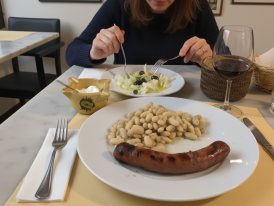
Grilled sausage on white beans
Botifarra Amb Mongetes
Grilled pork sausage over creamy white beans. Tavern classic.
Perfect for cold days when you want something that sticks to your ribs. This hearty meal appears on chalkboards across Poble-sec and Gràcia.
The sausage should have snap. The beans should be soft, glossy with oil, and seasoned properly. This isn't fancy cooking. It's Catalan dad food. The kind of Spanish dish that shows up on chalkboards in neighborhood taverns.
Order it with bread to mop up the bean juice.
Drink red wine. Argue about football.

Crema Catalana form Granja Viader
Crema Catalana
This is the one dessert everyone orders. Citrus and cinnamon custard with a caramelized sugar top. This sweet custard is the older cousin of crème brûlée. We will fight you if you say it the other way around about the French counterpart.
Granja Viader has been making it since 1870-something. The place is a heritage site now, all marble and dark wood. They serve hot chocolate thick enough to stand a spoon in. But the crema catalana is why people line up.
You crack the caramelized sugar with the edge of your spoon. The sweet custard underneath is cool, silky, and tastes like orange zest and cinnamon bark.
This creamy custard dessert satisfies any sweet tooth. Then you order another because one is never enough.
Escudella i carn d’olla is the stew that feeds you twice.

Escudella i carn d’olla with poached meat and baby carrots
My Must-Eat in Barcelona
This is the short list I hand to friends when they land, the dishes Barcelona orders for itself, cooked in rooms where the bread is good and the counters are crowded.
Pa amb tomàquet
Toasted country bread, rubbed with ripe tomato and garlic, finished with good oil and salt. Order it first, then judge a bar by how it treats the bread and oil. Try it at Bar del Pla, Can Culleretes, or La Pubilla for the benchmark version.
Calçots with romesco
Winter ritual, eaten with a bib and your hands. Charred green onions get peeled at the table and dunked in nutty romesco. Book a masia like Can Travi Nou or Can Cortada, or plan a Valls day trip in season.
Escudella i carn d’olla
The stew that feeds you twice. First the broth with pasta, then the meat and vegetables. Classic spots include Ca l’Isidre, Fonda España, and Casa Agustí.
Fideuà
Paella’s noodle cousin, toasted pasta cooked in seafood stock until it tastes like the sea. Best at lunch by the water. Can Solé, El Suquet de l’Almirall, and La Mar Salada are steady hands.
Botifarra amb mongetes
Grilled pork sausage with creamy white beans, tavern food done right. The beans should be soft and glossy with oil, the sausage with snap. Can Vilaró, Casa Mari y Rufo, or Can Pineda nail the brief.
Esqueixada de bacallà
Shredded salt cod salad with tomato and onion, bright and cold, perfect in summer. Order where the olive oil is taken seriously. Can Culleretes, Senyor Parellada, or Casa Delfín are reliable.
Canelons de Sant Esteve
Leftovers magic turned into béchamel-rich cannelloni, now a year-round craving. When you spot it on a menu, say yes. 7 Portes, Can Travi Nou, or Petit Comité keep the tradition alive.
Suquet de peix
Fishermen’s stew of rockfish and potatoes in a saffron-tinted broth. It is Barceloneta in a bowl. Book 7 Portes, Can Solé, or El Suquet de l’Almirall.
Bomba de la Barceloneta
A meat-filled potato ball with a one-two punch of sauces. Born in Barceloneta, still messy and perfect at the right counter. La Cova Fumada, La Bombeta, and Jai-Ca are the pilgrimage.
XatóEscarole, salt fish, olives, and a romesco dressing that makes the whole thing sing. Shows up on winter menus and Barcelona day trips down the coast. Cal Boter in Gràcia is a dependable city version.
Crema catalana
Silky citrus and cinnamon custard under a crackable sugar lid. Order one, then order another. Escribà, Cafè de l’Òpera, or Can Culleretes are classics.
Xurros amb xocolata
Thick hot chocolate with fresh-fried churros, the city’s winter afternoon fix. Go early or late to skip the line. Granja Dulcinea, Granja Viader, and La Pallaresa are the trifecta.
Cava
Local bubbles from Penedès poured like a casual drink with tapas. It belongs at the bodega as much as at a celebration. Start with El Xampanyet or Can Paixano.

Biryani from a street food stall late at night
How Global Is Barcelona’s Food Scene Right Now?
The Barcelona food scene isn't just Catalan cuisine. Walk through Raval after midnight. Seriously, Barcelona at night is a unique beast. You'll find Pakistani counters serving biryani. And Filipino spots doing adobo. Latin American joints with arepas and empanadas near Universitat metro. The diversity here enriches the city.
There are credible Peruvian kitchens. Japanese-Catalan fusion that locals love to eat at, not just food bloggers chasing content.
The diversity complements the Catalan backbone. It doesn't replace it. I'm not going to list the trendy spots because they'll be different by the time you read this. Ask around. Follow the line of people who look like they live here. Not the ones taking photos of the door.
Too Many Lists, Not Enough Clarity?
We make exploring simple by connecting you with someone who knows the city and helps you spend your time on what matters to you.
Plan your experience
La Cova Fumada exterior
Where Should You Grab Street Food in Barcelona?
Street food in Barcelona means market counters and old-school takeaway joints. This is where Barcelona food gets real.
La Cova Fumada invented the bomba. This is a fried roll of mashed potato and spiced ground meat. Topped with two sauces: a tomato-based sauce and a spicy brava sauce. It's messy, rich, the kind of thing you eat standing at a worn counter while old men argue about football.
Go early or don't bother. They run out before 2 PM.

Bomba at La Cova Fumada split open with sauces
El Quim de la Boqueria cooks baby squid with eggs right at the market counter. It's only worth the visit early, before the tourist crowds pack in. After 11 AM, skip it. The Sant Antoni market is where I shop. It may be busy at times, but it's so worth it.
Wider aisles, better flow, easier if you're pushing a stroller. The bars inside serve the same market food as La Boqueria market, but with room to breathe.
In winter, churros with thick hot chocolate. The deep-fried dough pairs perfectly with chocolate.
Year-round, bocadillos: cured ham in a crusty roll. Or a Spanish tortilla tucked into bread for lunch on the move. Some places do tortilla with hard-boiled egg mixed in.
That's not traditional, but it works. Simple snacks, maximum satisfaction.

Pastry case with xuixos and ensaimadas
Sweet Treats and Desserts
Granja Viader, again. Crema catalana, yes.
But also hot chocolate that could pass for pudding. They invented Cacaolat, the chocolate milk drink in glass bottles you see everywhere. The space feels like stepping into 1904. Food tour groups stop here constantly, but it's still worth the visit.
For pastries, xuixos are deep-fried cylinders stuffed with crema. They're Girona's invention, but Barcelona adopted them. These fried rolls appear in bakery windows across the city. Ensaimadas, those spiral Mallorcan pastries dusted with powdered sugar, show up everywhere, too.
I'm not a dessert person most days. But this city finishes meals with a grin. Sometimes I let it win.

Vermouth with orange peel shared with friends
What Do Locals Actually Drink, and When?
Vermouth hour runs from noon to 2 PM. Sometimes later on weekends.
Senyor Vermut is my pick in Eixample. They do vermut on tap, pair it with their bravas. Have a terrace that's pleasant off-peak. This is where locals drink before lunch.
El Xampanyet is the historic cava bar in El Born. Tiled walls, hanging hams, and cava served in wide-mouth glasses. Gets packed by 8 PM. Worth the squeeze if you can get in.
Quimet & Quimet is standing room only, always. Tiny space in Poble-sec, walls lined with wine bottles and preserved fish tins. They make montaditos, small toasts topped with whatever comes in fresh. No reservations, no chairs. Just show up and wedge yourself in. It's joyous, chaotic, perfect.
Craft beer exists here. Microbreweries in Poble-sec and El Born, if that's your preference. I drink what the room is drinking. Usually vermouth or cava with great wine as backup.
On weekends I do vermouth before lunch and again early evening.
Want to Experience Barcelona Firsthand?
Step into the neighborhood, scene, or story with someone who knows it inside out.
Which Neighborhoods and Markets Are Best for Eating?
The best food in Barcelona lives in neighborhoods, not on tourist strips. Local markets drive the flow here. Each area has its own character, its own bodegas and secrets.

Seaside table with paella
Barceloneta: Rice and Sea
Lunch at Can Solé, La Mar Salada, or Can Majó. These are the places to enjoy paella properly. Grilled fish if you're not in a paella mood. Walk the promenade after. Let the salt air settle the meal. This neighborhood is for long lunches that bleed into mid-afternoon. For old-school seafood and suquet, add 7 Portes or Cheriff to your shortlist.
Come hungry. Leave full. Take a nap.
Rice, sea, sunshine: done.

Sunlit aisle in Mercat de Sant Antoni
Sant Antoni: Market and Bodegas
This is my neighborhood. The market was renovated a few years back and reopened in 2018. Wider aisles, better accessibility, but kept the soul. Sunday mornings bring book stalls around the perimeter. Old men trading comics and first editions. Vermouth culture here is strong.
Every other corner has a bodega with marble counters and a chalkboard menu. The feel is daily, unglamorous, real. Food tour companies bring groups through here now. But it's still authentic enough to live in.
Beyond La Boqueria, go to Santa Caterina for its serious stalls and wild roof, Llibertat in Gràcia for a neighborly pace, and Concepció for its flowers and food under one roof.

Bar del Pla wine bar with snacks and wine
El Born: Wine and Clever Kitchens
Bar del Pla for croquetas and natural wine. El Xampanyet for cava and chaos. The streets here are narrow, Gothic, and lined with wine bars that fill up early. Book ahead or arrive when they open.
The natural wine scene is strong. Some of it is good. Some of it tastes like an accident. The staff will guide you if you let them.
This is where Barcelona food gets creative. Small plates with big opinions. For contemporary energy, book Disfrutar or Alkimia, sip natural wine at Bar Brutal, and line up for ramen at Ramen-ya Hiro.
Cocktail benchmarks are Paradiso and Dr. Stravinsky in El Born, bars get busy after 10 PM and clubs after 1 AM.
Curious What You Won’t Find Online About El Born?
Discover the side only locals talk about.

Quimet & Quimet standing bar with preserved-fish and wine
Poble-sec: Tiny Bodegas
Quimet & Quimet is the star here. But the whole neighborhood runs on tiny bodegas. Standing bars. Places where great food doesn't need chairs.
You stand, you eat, you drink, you leave. Sometimes you stay for three hours. Both are correct. The energy here is different.

Outdoor café tables in a leafy plaza
Gràcia: Plazas and Plant-Forward Plates
Gràcia invented Barcelona's vegan wave before it was trendy. The neighborhood also has family-run bars around squares.
Dinner moves slowly here. Nobody rushes you. Pick a plaza. Any plaza. Sit down. Let dinner find you. It usually does.
Gràcia Is Not Just a Place on a List
Experience it through hidden corners and stories most visitors miss.
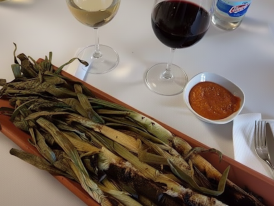
Charred calçots with romesco sauce
Unique Local Food Traditions
Thursday is arroz del día in the menú del día rotation. Rice dishes show up weekly in lunch menus across the city.
It's a tradition in Barcelona's food culture. People plan their week around it. Sunday paella by the sea is the family ritual. Friends gather, tables get pushed together. Wine flows. Rice gets scraped from the bottom of the pan.
This is when you'll see locals enjoy paella the traditional way.
Calçotadas run from January through March. Calçots are long spring onions, charred over open flame until black. Peeled, dipped in romesco sauce. You wear a bib. You make a mess. It's communal, loud, and one of the best food experiences the city offers.
This Catalan specialty comes from northeast Spain. The rich flavors develop in the charring.
I believe that traditions taste better when shared.
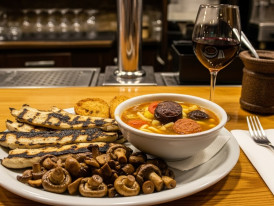
Seasonal collage: calçots, mushrooms, escudella
Seasonal Specialties
Winter: Escudella i carn d'olla, the stew that feeds you twice. First, the broth with pasta. Then the meat and vegetables. Crema Catalana for comfort on cold days.
Spring: Calçots with romesco sauce. Artichokes on the grill. Local markets turn green with fresh produce. This is peak season for vegetables.
Summer: Gazpacho, esqueixada, clams, razor clams. Everything cold and bright. Fresh seafood dominates the menus. Beach bars come alive.
Autumn: Mushrooms on toast, everywhere. Trinxat, mashed potato, and cabbage. Shows up in mountain-town menus. The markets shift to earthy flavors.
Eat with the weather. The city's food calendar follows logic. Hot food when it's cold. Cold food when it's hot. It all clicks when you eat in Barcelona this way.
What If Your Next City Day Didn’t Come From a Guidebook?
Instead of following a script, we connect you with someone who lives there and knows the places worth your time.
Tourist strip vs cosy neighborhood bar
Overrated Food Experiences
Paella on La Rambla: I mentioned this earlier, but I'll risk repeating myself here because I really think you should heed my 'warning.' Skip it entirely. Tweak to lunch by the sea at Can Solé, La Mar Salada, or Can Majó (genuinely my recommendations). The quality difference is extreme. Tourist traps serve terrible paella.
Sangria pitchers with meals: Tourists drink sangria. Locals drink vermouth or cava. Follow the room. Don't be the table with the fishbowl.
La Boqueria market front-row counters: Go early for El Quim if you must. Otherwise, choose Mercat de Sant Antoni. La Boqueria market gets crushed by crowds. The quality drops when the tour buses arrive.
Tapas restaurants with photo menus: If the menu has pictures and eight languages, keep walking. Go to Bar del Pla, Quimet & Quimet, or El Xampanyet instead.
Real tapas bar culture doesn't need photos. The rule is simple. If it looks staged, it probably tastes staged.

Bar entry with small step and alternative ramp sign
Practical Tips for Eating in Barcelona
Timing: Best value comes at lunch. Menú del día is the city's gift to anyone paying attention. Tapas bars warm up around 8 PM. Local markets reward early birds. Get to markets by 10 AM for the best selection.
Booking: Reserve rice houses on weekends. For bodegas, walk-in patience is the only currency. Calling ahead helps for Bar del Pla. Most neighborhood spots don't take reservations.
Money: Cards work almost everywhere now. Keep coins for tiny bars. Some old bodegas prefer cash. So bring both.
Etiquette: Don't hover while waiting for a table. Queue politely. Give the bar staff space to work. This isn't Southern California; the pace is different here.
Dietary needs: Vegetable-forward options are common in Gràcia and Eixample. Gluten-free bakeries exist. Ask the staff. They'll guide you.
Accessibility: Sant Antoni market has wide aisles, ramps, and room to move. Classic bodegas can be narrow, standing-only spaces.
For seated alternatives, La Mar Salada and other rice houses have proper table service. Accessible entry too.
Go with the flow. Eat in Barcelona the way locals do. The city feeds you back.
Before You Go, Talk to Someone Who Knows
A local video call helps you plan the trip that’s right for you.
Frequently Asked Questions
1) What time do locals eat dinner?
Between 9 PM and 11 PM, usually. Dinner happens late here. If you're hungry at 7 PM, have a snack. Tapas bars won't be busy yet.
2) Is pa amb tomàquet just tomato toast?
Technically yes. Spiritually no. It's about the quality of bread, oil, and tomato. When done right, it's perfect. When done wrong, it's sad. Pan con tomate is the Spanish term for the same dish.
3) How spicy is spicy brava sauce?
Not very, by global standards. It has heat, but it won't hurt you. If Bar Tomás' version is too spicy, you might need to recalibrate. Most versions are mild with a slight kick.
4) Are tapas restaurants family-friendly at night?
Most are. Locals bring kids to tapas bar spots until late. Nobody blinks. Children are welcome in Barcelona's food culture.
5) Can I find street food late at night?
Raval has late-night counters. Kebab shops, Pakistani spots, Filipino food. Open past midnight. Perfect for when the bars close.
6) What's the difference between pa amb and pan con tomate?
"Pa amb" means bread with something in Catalan. "Pan con tomate" is specifically bread with tomato in Spanish. You'll also see pa amb oli, bread with oil. Same concept, different toppings.
7) Do locals take a cooking class to learn how to make arroz or romesco sauce?
Some do. Most learn from family or by eating out a lot and paying attention. A cooking class can teach you the basics. But the best education is eating.
8) What's one delicious dish visitors miss?
Esqueixada. Most tourists don't order shredded salt cod. Their loss. It's one of the lightest, brightest dishes you'll find.
9) Is the Gothic Quarter good for food or just for photos?
Mixed. Lots of tourist traps in the Gothic Quarter. El Born, which borders it, has better Barcelona food. Look for hidden gems in Barcelona beyond the main drags if you want the real spots.
10) I'm visiting Barcelona for a weekend. What's a simple route to eat well?
Saturday: Market breakfast at Sant Antoni. Lunch at Can Solé. Vermouth at Senyor Vermut. Tapas at Bar del Pla.
Sunday: Brunch, walk in Barceloneta, dinner in Poble-sec or Gràcia. Keep it simple.
See more things to do in Barcelona for the full picture. A food tour can show you the highlights fast.
11) How do I buy good olive oil to take home?
Local markets sell it. Look for DO labels, Denominación de Origen. Ask for a taste before buying. Smaller producers make the best stuff. Extra virgin olive oil from Catalunya has distinct peppery notes. Worth the suitcase space.
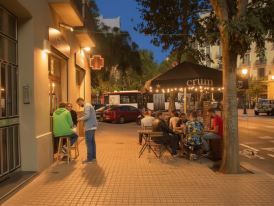
Night street in Sant Antoni with warm bar light
Final Thoughts
My suggestion: eat slowly here. Argue about sauces with the bartender. Walk between bites. Let the city show you its vibe before you try to speed it up.
I spend my days eating, walking, and writing about Barcelona food. When friends visit, I take them to the same local markets I shop at. The same bars where I'm on first-name terms with the staff.
Sometimes I host guests throughout the neighborhoods, showing them how locals actually eat in Barcelona.
Where to order, when to arrive. It's not a food tour. It's just eating like a person who lives here. Barcelona feeds you if you let it. Show up curious. Respect the hours. Don't fill up on mediocre paella when world-class rice is twenty minutes away.
The city's best food happens at marble counters in neighborhood bodegas. At rice houses by the water. In markets where people still shop for tonight's dinner. Eat where the city still shops, and it will feed you back.
For more ways to experience the country beyond Barcelona, explore other Spain experiences as recommended by locals, not guidebooks.
More on Barcelona
Ready to Plan Your Perfect Day in Barcelona?
Start your experienceTravel Guides Can Only Take You So Far
City Unscripted connects travelers with locals who shape days that actually fit your interests — not someone else’s checklist.
Discover the differenceWish You Had a Local Friend in Barcelona?
One who knows the city inside out and could plan a private day just for you? Our local hosts do exactly that: no scripts, no tourist traps, just the side of the city most people miss.
